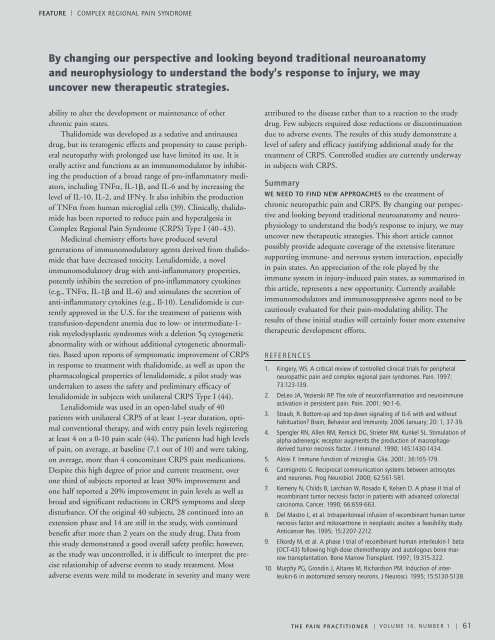printer-friendly version (PDF) - Reflex Sympathetic Dystrophy ...
printer-friendly version (PDF) - Reflex Sympathetic Dystrophy ...
printer-friendly version (PDF) - Reflex Sympathetic Dystrophy ...
You also want an ePaper? Increase the reach of your titles
YUMPU automatically turns print PDFs into web optimized ePapers that Google loves.
FEATURE | COMPLEX REGIONAL PAIN SYNDROME<br />
By changing our perspective and looking beyond traditional neuroanatomy<br />
and neurophysiology to understand the body’s response to injury, we may<br />
uncover new therapeutic strategies.<br />
ability to alter the development or maintenance of other<br />
chronic pain states.<br />
Thalidomide was developed as a sedative and antinausea<br />
drug, but its teratogenic effects and propensity to cause peripheral<br />
neuropathy with prolonged use have limited its use. It is<br />
orally active and functions as an immunomodulator by inhibiting<br />
the production of a broad range of pro-inflammatory mediators,<br />
including TNF, IL-1, and IL-6 and by increasing the<br />
level of IL-10, IL-2, and IFN. It also inhibits the production<br />
of TNF from human microglial cells (39). Clinically, thalidomide<br />
has been reported to reduce pain and hyperalgesia in<br />
Complex Regional Pain Syndrome (CRPS) Type I (40-43).<br />
Medicinal chemistry efforts have produced several<br />
generations of immunomodulatory agents derived from thalidomide<br />
that have decreased toxicity. Lenalidomide, a novel<br />
immunomodulatory drug with anti-inflammatory properties,<br />
potently inhibits the secretion of pro-inflammatory cytokines<br />
(e.g., TNF, IL-1 and IL-6) and stimulates the secretion of<br />
anti-inflammatory cytokines (e.g., Il-10). Lenalidomide is currently<br />
approved in the U.S. for the treatment of patients with<br />
transfusion-dependent anemia due to low- or intermediate-1-<br />
risk myelodysplastic syndromes with a deletion 5q cytogenetic<br />
abnormality with or without additional cytogenetic abnormalities.<br />
Based upon reports of symptomatic improvement of CRPS<br />
in response to treatment with thalidomide, as well as upon the<br />
pharmacological properties of lenalidomide, a pilot study was<br />
undertaken to assess the safety and preliminary efficacy of<br />
lenalidomide in subjects with unilateral CRPS Type I (44).<br />
Lenalidomide was used in an open-label study of 40<br />
patients with unilateral CRPS of at least 1-year duration, optimal<br />
conventional therapy, and with entry pain levels registering<br />
at least 4 on a 0-10 pain scale (44). The patients had high levels<br />
of pain, on average, at baseline (7.1 out of 10) and were taking,<br />
on average, more than 4 concomitant CRPS pain medications.<br />
Despite this high degree of prior and current treatment, over<br />
one third of subjects reported at least 30% improvement and<br />
one half reported a 20% improvement in pain levels as well as<br />
broad and significant reductions in CRPS symptoms and sleep<br />
disturbance. Of the original 40 subjects, 28 continued into an<br />
extension phase and 14 are still in the study, with continued<br />
benefit after more than 2 years on the study drug. Data from<br />
this study demonstrated a good overall safety profile; however,<br />
as the study was uncontrolled, it is difficult to interpret the precise<br />
relationship of adverse events to study treatment. Most<br />
adverse events were mild to moderate in severity and many were<br />
attributed to the disease rather than to a reaction to the study<br />
drug. Few subjects required dose reductions or discontinuation<br />
due to adverse events. The results of this study demonstrate a<br />
level of safety and efficacy justifying additional study for the<br />
treatment of CRPS. Controlled studies are currently underway<br />
in subjects with CRPS.<br />
Summary<br />
WE NEED TO FIND NEW APPROACHES to the treatment of<br />
chronic neuropathic pain and CRPS. By changing our perspective<br />
and looking beyond traditional neuroanatomy and neurophysiology<br />
to understand the body’s response to injury, we may<br />
uncover new therapeutic strategies. This short article cannot<br />
possibly provide adequate coverage of the extensive literature<br />
supporting immune- and nervous system interaction, especially<br />
in pain states. An appreciation of the role played by the<br />
immune system in injury-induced pain states, as summarized in<br />
this article, represents a new opportunity. Currently available<br />
immunomodulators and immunosuppressive agents need to be<br />
cautiously evaluated for their pain-modulating ability. The<br />
results of these initial studies will certainly foster more extensive<br />
therapeutic development efforts.<br />
REFERENCES<br />
1. Kingery, WS. A critical review of controlled clinical trials for peripheral<br />
neuropathic pain and complex regional pain syndromes. Pain. 1997;<br />
73:123-139.<br />
2. DeLeo JA, Yezierski RP. The role of neuroinflammation and neuroimmune<br />
activation in persistent pain. Pain. 2001; 90:1-6.<br />
3. Straub, R. Bottom-up and top-down signaling of IL-6 with and without<br />
habituation? Brain, Behavior and Immunity. 2006 January; 20: 1; 37-39.<br />
4. Spengler RN, Allen RM, Remick DG, Strieter RM, Kunkel SL. Stimulation of<br />
alpha-adrenergic receptor augments the production of macrophagederived<br />
tumor necrosis factor. J Immunol. 1990; 145:1430-1434.<br />
5. Aloisi F. Immune function of microglia. Glia. 2001; 36:165-179.<br />
6. Carmignoto G. Reciprocal communication systems between astrocytes<br />
and neurones. Prog Neurobiol. 2000; 62:561-581.<br />
7. Kemeny N, Childs B, Larchian W, Rosado K, Kelsen D. A phase II trial of<br />
recombinant tumor necrosis factor in patients with advanced colorectal<br />
carcinoma. Cancer. 1990; 66:659-663.<br />
8. Del Mastro L, et al. Intraperitoneal infusion of recombinant human tumor<br />
necrosis factor and mitoxantrone in neoplastic ascites: a feasibility study.<br />
Anticancer Res. 1995; 15:2207-2212.<br />
9. Elkordy M, et al. A phase I trial of recombinant human interleukin-1 beta<br />
(OCT-43) following high-dose chemotherapy and autologous bone marrow<br />
transplantation. Bone Marrow Transplant. 1997; 19:315-322.<br />
10. Murphy PG, Grondin J, Altares M, Richardson PM. Induction of interleukin-6<br />
in axotomized sensory neurons. J Neurosci. 1995; 15:5130-5138.<br />
T H E PA I N P R A C T I T I O N E R | V O L U M E 16 , N U M B E R 1 | 61
















